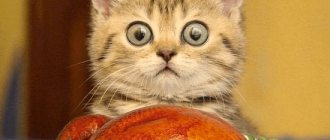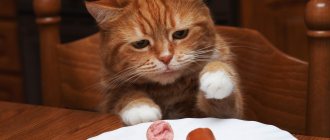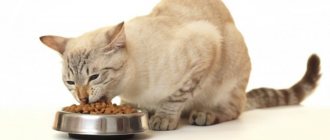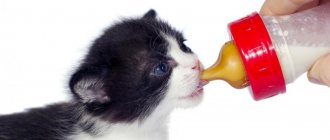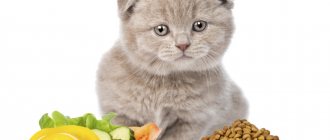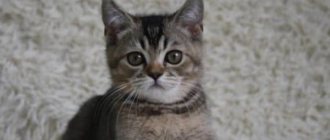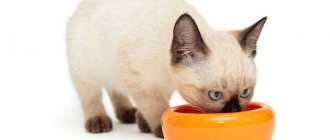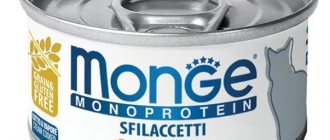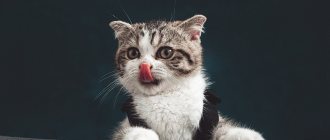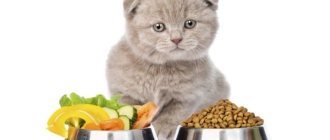Many people think that feeding a kitten is simple, because for centuries our ancestors in the villages simply gave the leftovers of dinner to their pets. It seems that it is enough to pour the remaining soup into a bowl, add a little meat or fish - and all this is enough for your pet. As a last resort, you can buy the most ordinary food in the store and not have to worry about choosing a menu. But everything is not so simple if you want your pet to be healthy, vigorous and live a long time. There are some nuances in creating a diet for kittens.
Feeding kittens without a cat
In the first days of life, mother's milk helps the kitten better adapt to new conditions. But it happens that babies are deprived of parental warmth early. You have to feed the kitten yourself. A special mixture that is sold in pet stores is suitable for this. It should be used to feed kittens in the first month after birth.
You cannot replace the mixture with cow's milk - it is permissible to use it only after a month, otherwise the kittens will develop diarrhea, and they may even die, because their stomachs are still very weak to digest complex food. It’s better to feed your baby goat’s milk for some time after using a mother’s milk substitute. This rule is relevant not only for purebred animals, but also for yard kittens.
For feeding, it is convenient to use a pipette or a bottle with a small nipple (all of this is also sold in pet stores). The second option is more preferable, since it is important to develop a sucking reflex in the baby. If it is not yet available, use a pipette to get a few drops of the mixture into the kitten's mouth, and then immediately apply it to the nipple - this way he will understand what needs to be done. In addition to the mixture, you can give the kitten warm water using a pipette or syringe.
Another option is to find a wet nurse. A cat that has recently given birth can feed a baby left without a mother.
Vitamins, minerals
Vitamins, minerals, amino acids must be supplied to the kitten’s body with food and feed. Ready-made high-quality feed contains all the necessary substances, so the ready-made diet is not supplemented with vitamin-mineral complexes and additives.
If the kitten receives natural food, to replenish the deficiency of vitamins, minerals, amino acids, ask your veterinarian what vitamin preparations to give your pet.
It is best to use complex formulations (Brevers, Stress Tabs for kittens) in tablets, capsules, or powder. At five months, the kitten’s body needs proteins, amino acids, calcium, phosphorus, iodine, iron, vitamins A, B, C.
Basic rules for feeding a newborn kitten
If the formula option is not suitable, try preparing food for your baby from milk and yolk. The components are taken in a 4:1 ratio and blended in a blender. You will get a thick mixture that needs to be diluted with water. The resulting product can be fed to newborn kittens. Just remember that chicken eggs must be fresh.
1 month
After the baby is 3-4 weeks old, you can include new foods in his diet. For the first complementary feeding, it is better to use products similar in composition to breast milk. For example, this is meat puree for children. They do not complicate digestion and are pleasant to the taste. You need to start with 1 meal a day, gradually increasing meals with new foods.
2 months
The diet doesn't change much. You can try including dry food in your diet. In addition to purees, you need to give your kitten solid food. The food does not need to be ground or chopped - the animal can handle it quite well. As the kittens grow, they will eat more. You can add cottage cheese, greens, pumpkin, porridge, cabbage, and raw yolk to your diet. These foods will help dry food digest better and reduce the likelihood of constipation. At this age, animals cannot yet control portions, and you need to make sure that they do not overeat. The first time, foods should be given in small quantities so that the body gets used to the new regime.
3 months
This is the period when babies' teeth begin to change. For their normal growth, you should include more solid food in your diet. It is acceptable to feed the kitten raw meat, but this will require additional use of deworming medications. Small bones will also work. By this age, the dosage is already clear to the animal, and he begins to eat in accordance with his appetite.
It is acceptable to include vegetables, boiled fish, cottage cheese, milk porridge, and yoghurt in the menu. And if previously the pet ate 8-10 times a day, now you can simply arrange 3 full meals. If you get used to this gradually, when the kitten is left at home alone, he will not go hungry.
5 months and older
You can give your pet food for adult animals. It is permissible to sprout grass that the kitten will eat from the flowerpot - it will help the food to be digested normally.
Mixed nutrition
Among veterinarians and cat lovers, there are 2 diametrically opposed opinions regarding feeding a 2-month-old kitten with a mixed diet:
- Mixed food is ideal for kittens . Thanks to this type of feeding, the pet receives all the necessary nutrients and vitamins during the period of active growth and development.
- Mixed food is harmful to the kitten's body . Industrial foods and natural products contain the same vitamins. And this is fraught with the development of hypervitaminosis.
Both opinions are correct in their own way. But still, most veterinarians agree that using a mixed diet is acceptable, but in exceptional cases. The main thing to remember is that you cannot combine natural and industrial products in one bowl.
Also watch the video of what to feed a kitten at 2 months:
Feeding tips
When using natural food, it is important that the food is always fresh. The only possible exception is kefir. Also consider the following rules:
- animals should not be given smoked meats and pickles (even if these are meat or fish products);
- food should be warm, but not scalding;
- After each meal you need to wash the bowl;
- pieces that are too coarse need to be chopped even for an adult animal.
Natural: basic rules
When feeding homemade food, do not teach the animal to eat from the table, do not feed it leftover food during lunch. The kitten must understand where its bowl is located, and that food for it is located only in this place. Otherwise, you risk getting a beggar who will also steal food from the table.
Don't forget about vitamins that are important for a growing body. We also already talked about sprouting weed. Instead, you can plant wheat, the sprouts of which kittens are also very fond of.
Food basket
For a pet, you should buy beef, not pork, which is too fatty for a fragile body. Chicken, turkey, and sea fish are suitable. The latter is also good because it does not contain helminths that the kitten can become infected with. However, you shouldn’t even give sea fish too often - it’s enough to include it in the diet 1-2 times a week. Canned fish is also allowed, but due to the high salt content and high fat content, it is better to mix them with cereals.
Not all cats drink milk. Moreover, an older kitten does not need it; it is better to replace it with fermented milk products. If the kitten refuses this product, experiment with kefir and yogurt without additives. Control the fat content level - it is better to choose 2.5% options. Low-fat products are also not suitable due to the high sugar content in the composition.
Kittens love yolk and cottage cheese puree, sour cream, porridge with pieces of meat or vegetables, broths and soups. Just make sure that they do not contain legumes - this product is difficult to digest.
Ready-made feed
Often a certain breed of cat requires the use of artificial food. This method is also chosen by owners who are too busy and cannot constantly prepare food for their pet. Ready-made food has one important advantage - it already contains as many vitamins and minerals as the animal requires for normal development. It is better to accustom an animal to solid food gradually, starting with canned food.
Bosch Sanabelle wet food
This option belongs to the premium class and comes from Germany. Among the advantages, it is worth highlighting the balanced composition, in which the majority is animal protein, as well as the absence of artificial ones. However, the downside is that this food contains cellulose and maize - kittens are often allergic to these components. Therefore, it would be right to buy a small amount of food and see how your pet reacts to it.
Hills – food for kittens
This is another premium food that often has counterfeits, so buy it only in trusted stores. Among the advantages is a rich complex of vitamins and minerals. However, a high percentage of carbohydrates that are poorly absorbed by a growing body, a large amount of vegetable protein and a high likelihood of developing allergies are important disadvantages. There is also quite a lot of liquid in the package.
ProPlan Junior
This premium food is affordable, and many owners choose it. The brand is presented in many stores, and purchasing such food is not a problem. One of the advantages is the presence of probiotics in the composition, many types. But the product contains a lot of preservatives and vegetable protein.
What should you not feed?
For newborn kittens the following are prohibited:
- Raw cow's milk, food is difficult to digest in the gastrointestinal tract of a tiny animal.
- Milk diluted with water and complementary foods are not nutritious enough; the baby does not receive the required amount of microelements and vitamins.
- Kefir, fermented baked milk, sour cream, yogurt, the baby’s stomach is not able to digest.
- Sausage, meat, cheese, and other products are harmful to the body of a newborn kitten.
- Minced fish, possible parasitic infection.
Products undesirable for kittens
Despite the fact that 20 years ago in villages cats were fed leftovers from dinner, and the animals did not have any problems with nutrition, modern pets have a more sensitive digestive tract.
In addition, they live in different conditions, and their immunity is not adapted to survive extreme situations. That is why it is better to exclude the following products from the animal’s diet:
- sausages, sausages, smoked meats;
- rice;
- bread and buns;
- margarine and butter;
- pasta;
- mushrooms and legumes;
- tomatoes;
- sweets.
Of course, nothing will happen to the kitten from one piece, but systematic consumption of such products will shorten the pet’s lifespan.
Dangerous foods for kittens
It is important to eliminate raw foods from your diet whenever possible. This is especially true for pork and river fish - they contain a lot of worms. It is better to boil and chop these products or replace them with lean meat and sea fish. You should also avoid seafood (shrimp, mussels).
Extremely dangerous products
Chocolate is very dangerous even for adult cats. Its consumption can cause the death of the animal. This product contains theobromine, which is absolutely not excreted from the cat’s body and accumulates in dangerous concentrations. The same applies to large bones, fragments of which can injure internal organs. It is strictly forbidden to give kittens expired food and medications prescribed for humans.
Also, depending on the breed, there may be certain dietary restrictions. For example, Maine Coons do not really like fish and digest it poorly, and Sphynx cats should not be given fatty foods.
Water in the diet
The process of transitioning from cat milk or milk replacer involves gradually increasing your drinking water intake. Water is very important to keep kittens healthy and active. At about 4 weeks of age, as soon as the kittens begin to eat solid food, they need to have access to clean, fresh water.
It is advisable not to use a plastic bowl; it should be made of metal, glass or porcelain. It is better to place the bowl a little away from the place where the kittens eat. You can place several bowls of water throughout the apartment. A good solution would be to purchase a special drinking fountain.
Water is very important for a kitten's health
Basic rules of care
It is necessary to accustom the kitten to the bowl, not allowing him to take food in other places. Your pet may also refuse to eat from it if the container is dirty or inconveniently located. Therefore, make sure that the bowl is in a place where there are no drafts, or not on a walkway where household members could accidentally touch the kitten. The bowl needs to be washed regularly.
The play area and the feeding area should be located separately from each other so that the kitten does not spread leftover food around the room.
How many times a day should you feed a kitten?
Babies up to 3-4 months need to be fed 8-10 times a day due to the fact that their digestive system is still very weak and cannot digest a large amount of food at once. In the future, you can reduce the number of meals to 3-4 times a day.
Kitten food table
When creating a menu for small kittens, you can rely on the following table:
| Product | Can I give it to a kitten? |
| banana | No |
| borsch | No |
| broccoli | Yes |
| buckwheat | Yes |
| baby food | Yes |
| potato | No |
| semolina | No |
| carrot | Yes |
| cucumber | Yes |
| liver | Yes |
| ground meat | Yes |
| bread | No |
| egg | Yes |
| apple | Yes |
At what age can dry food be given and how exactly?
As soon as the kitten can physically transition from milk to solid food. You can start complementary feeding slowly from 3.5–4 weeks - a few soaked granules per day, and from 5–6 weeks you can feed exclusively dry food. It is convenient and absolutely safe if you have selected food that meets the criteria above.
If it seems to you that the baby cannot cope with the granules or does not show interest in them, at first you can continue to soak the food with warm water. Each portion will have to be prepared anew. Read more about how to switch a kitten to dry food from milk, natural food or wet food here. The scheme is also valid when transferring from one dry food to another.
